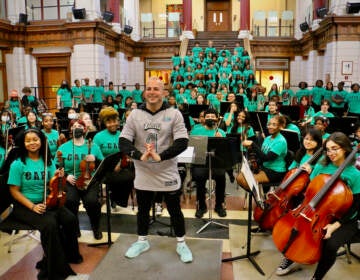Philadelphia Orchestra principal trumpet breaks down the Olympic theme
Philadelphia Orchestra principal trumpet David Bilger explains the “energy and brilliance” of the Olympic theme to Morning Edition host Jennifer Lynn.
Listen 5:09
David Bilger is principal trumpeter of the Philadelphia Orchestra. (Kimberly Paynter/WHYY)
The “Olympic Fanfare and Theme” song has been played umpteen times during the Summer Games, especially during those televised sports updates.
This version of the song was composed by the great John Williams — who loves writing music for the trumpet.
WHYY Morning Edition host Jennifer Lynn had to ask the Philadelphia Orchestra’s principal trumpet, David Bilger, about it. He’s worked under maestro Williams and performed the song live at least ten times in his career.
He says the song is quite a workout.
–
It’s really physical. One of the joys of John Williams’ music is that he finds a way to find this emotional connection, whether it’s a moment in “E.T.” of “what’s going to happen next?” where you hear the shimmering strings, or whether it’s the big heroic moment. And obviously, this Olympic theme, especially the trumpet flourish, is all about the heroism that goes into it. It’s a physical pursuit, the Olympics. And, in a way, what he wrote for us is very physical as well.
The song is played powerfully, yet it’s performed with the utmost control.
It starts right away, right? So you don’t get to warm up into it. It’s like ready, set, go. It’s sort of like the 100 meters, where it’s like, OK, you want to get out of the blocks right away. Well, it’s the same thing we need to do.
*mimics trumpet sound*
And it’s all this energy and brilliance. And you want to try to capture that feeling from the first notes.
Are you ever afraid you’re going to miss a note? It’s fast, right?
I was watching gymnastics at the Olympics and it’s a little like, maybe the women on the balance beam. If you think about falling, you’re in a bad place. So we don’t think so much about whether we’re going to miss. It’s more about envisioning what you want it to sound like.
David, are you prepared to play a little bit for us? A few different things? I asked nicely!
Sure.
I was reading a little bit about you in your lovely biography and it says you’re known for your “engaging legato touch.” I’d love to hear that legato touch.
*plays light trumpet pattern*
That’s just a scale, but it gives you a sense of that warmth of sound that I like to make on the horn.
Can we get to hear some of the flourish of this?
Sure.
And maybe as you do a little bit, you could break it down for us, if that makes any sense and kind of explain either an attack or what you’re thinking.
OK, I’ll do the start of it. OK.
*plays opening flourish of “The Olympic Fanfare and Theme”*
OK, so when I’m starting that, I’m just thinking about rhythm first, so I’m getting this pulse going, that’s where it all all comes from. It’s all about time. There’s no drum set in this. There’s no rhythm section like if it were a rock band. So you have to feel it inside. And then I’m going to take a breath on the last beat before, so I’m ready to just shoot the air straight through the horn and then let it go. One, two, three.
*repeats flourish*
And that’s how I’m getting that start, and you hear that it’s got that brilliance to it.
Oh, that is wonderful.
The next big challenge is going up to the high note. That’s the big moment of that first phrase, and that’s usually where they end on the TV broadcast, before the beautiful melody that comes in. The strings and French horns come in next. And that’s just a matter of just like, ready, set, go up to the high note. It’s letting the air rip through the horn.
You nailed the landing. It was really great.
Well, thank you. No step back for me?
So this is performed in a really high range of the trumpet. Is that a difficult thing, to be in the high range?
High notes are in a way a little easier to miss because … just the physics of the instrument, the notes are… They feel closer together when you play them. So it’s easy to sort of hit the wrong one.
What makes for an amazing orchestral trumpet part for the ages?
Impact. Emotionalism. And that can be heroic, like we’re talking about with this John Williams score, but it could also be something that moves somebody to tears. It’s the emotional impact of the music. And that’s why it’s incumbent upon us as performers to trust the technique and try to say the most that we can musically. It’s a language and we want to reach people. I think those best trumpet parts all have that in common, is that they make us feel something.
Well, this has been really special and wonderful. A lot of insight into playing the song and just using the trumpet in general. I really appreciate that.
Oh, sure. It’s my pleasure.

Get daily updates from WHYY News!
WHYY is your source for fact-based, in-depth journalism and information. As a nonprofit organization, we rely on financial support from readers like you. Please give today.






